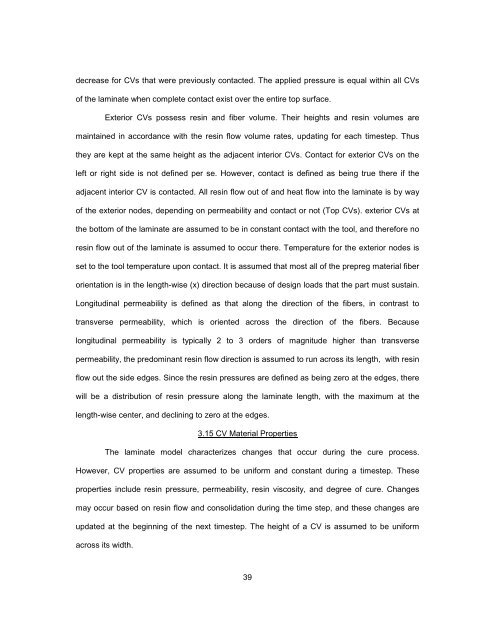TOOLED THICK COMPOSITES by ARVEN H. SAUNDERS III ...
TOOLED THICK COMPOSITES by ARVEN H. SAUNDERS III ...
TOOLED THICK COMPOSITES by ARVEN H. SAUNDERS III ...
Create successful ePaper yourself
Turn your PDF publications into a flip-book with our unique Google optimized e-Paper software.
decrease for CVs that were previously contacted. The applied pressure is equal within all CVs<br />
of the laminate when complete contact exist over the entire top surface.<br />
Exterior CVs possess resin and fiber volume. Their heights and resin volumes are<br />
maintained in accordance with the resin flow volume rates, updating for each timestep. Thus<br />
they are kept at the same height as the adjacent interior CVs. Contact for exterior CVs on the<br />
left or right side is not defined per se. However, contact is defined as being true there if the<br />
adjacent interior CV is contacted. All resin flow out of and heat flow into the laminate is <strong>by</strong> way<br />
of the exterior nodes, depending on permeability and contact or not (Top CVs). exterior CVs at<br />
the bottom of the laminate are assumed to be in constant contact with the tool, and therefore no<br />
resin flow out of the laminate is assumed to occur there. Temperature for the exterior nodes is<br />
set to the tool temperature upon contact. It is assumed that most all of the prepreg material fiber<br />
orientation is in the length-wise (x) direction because of design loads that the part must sustain.<br />
Longitudinal permeability is defined as that along the direction of the fibers, in contrast to<br />
transverse permeability, which is oriented across the direction of the fibers. Because<br />
longitudinal permeability is typically 2 to 3 orders of magnitude higher than transverse<br />
permeability, the predominant resin flow direction is assumed to run across its length, with resin<br />
flow out the side edges. Since the resin pressures are defined as being zero at the edges, there<br />
will be a distribution of resin pressure along the laminate length, with the maximum at the<br />
length-wise center, and declining to zero at the edges.<br />
3.15 CV Material Properties<br />
The laminate model characterizes changes that occur during the cure process.<br />
However, CV properties are assumed to be uniform and constant during a timestep. These<br />
properties include resin pressure, permeability, resin viscosity, and degree of cure. Changes<br />
may occur based on resin flow and consolidation during the time step, and these changes are<br />
updated at the beginning of the next timestep. The height of a CV is assumed to be uniform<br />
across its width.<br />
39
















